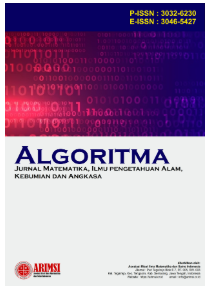Analisis Kemampuan Numerasi Peserta Didik Kelas 1 Madrasah Ibtidaiyah Berdasarkan Level Kognitif
DOI:
https://doi.org/10.62383/algoritma.v3i4.638Keywords:
Numeracy-Skills, Mathematics, Cognitive-LevelsAbstract
This study aims to identify the numeracy ability of grade I students of Madrasah Ibtidaiyah Based on Cognitive Level. The research method used is quantitative with a descriptive approach. The population used by all students of MIN 4 Medan. Sampling from the population used the Issac Michael technique which obtained a result of 249 from the entire population. Furthermore, samples were taken using cluster sampling which was specifically for classes I, A and I B, a total of 56. The test instrument is in the form of an objective description of the "filling" and the results are in the form of scores. The data analysis in this study is a descriptive quantitative data analysis. The results showed the numeracy ability of students in class I MIN 4 Medan, namely: 1) the level of remembering for the "high" category was 37 students or 75.51%; for the "medium" category: there are 4 students or 8.16%; and the "low" category there are 8 students or 16.32%. 2) the level of understanding for the "high" category was 28 students or 57.41%; the "medium" category has 16 students or 32.65%; and the "low" category there are 5 students or 10.20%. 3) the application rate for the "high" category was 18 students or 36.73%; the "medium" category has 29 students or 59.18%; and the "low" category has 2 students or 4.08%. The implication in this study is to increase the practice of contextual questions and carry out game-based learning.
Downloads
References
Adinda, D. W., Nurhasanah, & Oktavianty, I. (2022). Profil kemampuan numerasi dasar siswa sekolah dasar di SDN Mentokan. Jurnal Ilmiah Profesi Pendidikan, 7(3).
Andhany, E., & Maysarah, S. (2023). Pengembangan modul pembelajaran digital interaktif berbasis literasi matematika. AKSIOMA: Jurnal Program Studi Pendidikan Matematika, 12(3), 3503. https://doi.org/10.24127/ajpm.v12i3.6299
Anggraini, L. G., & Anas, N. (2019). Analisis kemampuan metakognisi siswa terhadap materi bangun ruang di SD. Elementary School Journal PGSD FIP Unimed, 9(4), 335. https://doi.org/10.24114/esjpgsd.v9i4.16384
Anifarka, A., & Rosnawati, R. (2023). Analisis buku teks matematika SMP berdasarkan tingkat kognitif pada Taksonomi Bloom revisi dan numerasi pada AKM. Jurnal Cendekia: Jurnal Pendidikan Matematika, 7(3), 2151–2166. https://doi.org/10.31004/cendekia.v7i3.1701
Cahyanovianty, A. D. (2020). Analisis kemampan numerasi peserta didik kelas VIII dalam menyelesaikan soal asesmen kompetensi minimum. Jurnal Pendidikan, 5(2), 1439–1448.
Ekowati, D. W., & Suwandayani, B. I. (2019). Literasi numerasi untuk sekolah dasar. Universitas Muhammadiyah Malang.
Narpila, S. D., Ar Rackhman, A., & Zaini, M. (2021). Teori dan aplikasi pembelajaran matematika di SD/MI. Yayasan Penerbit Muhammad Zaini.
Pusat Asesmen dan Pembelajaran. (2020). Asesmen kompetensi minimum. Kemendikbud.
Putri, D. A., & Rizky, R. W. (2023). Analisis kesulitan belajar siswa sekolah dasar kelas II pada materi penjumlahan dan pengurangan SD IT Hidayatul Jannah. Jurnal Pendidikan Tambusai, 7(3).
Saputra, G. (2015). Tingkat pengetahuan tentang kesehatan pribadi siswa kelas atas SD Negeri 2 Sokawara [Skripsi, Universitas Negeri Yogyakarta].
Sulistyawati, W., Wahyudi, W., & Trinuryono, S. (2022). Analisis motivasi belajar siswa dengan menggunakan model pembelajaran blended learning saat pandemi COVID-19 (deskriptif kuantitatif di SMAN 1 Babadan Ponorogo). KadikmA, 13(1), 68–73.
Yusnaldi, E. (2018). Pembelajaran IPS MI/SD. CV Widya Puspita.
Downloads
Published
How to Cite
Issue
Section
License
Copyright (c) 2025 Algoritma : Jurnal Matematika, Ilmu pengetahuan Alam, Kebumian dan Angkasa

This work is licensed under a Creative Commons Attribution-ShareAlike 4.0 International License.





